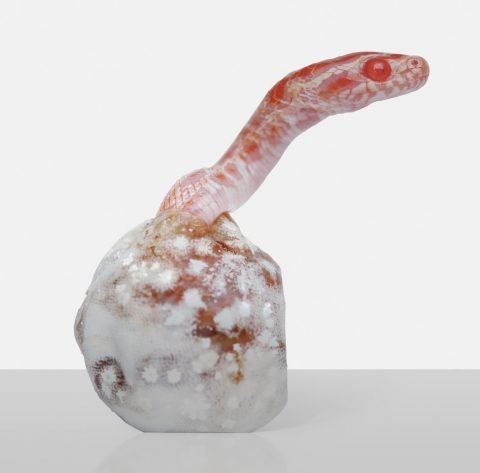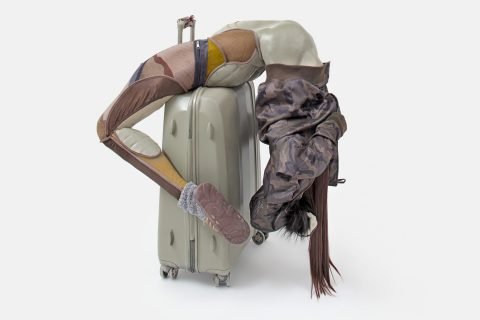Six steps into artists’ current fascination with the third dimension
- Damien Hirst, The Warrior and the Bear, Photographed by Prudence Cuming Associates © Damien Hirst and Science Ltd. All rights reserved, DACS, 2017.
- Bruno Gironcoli, Untitled, 1993-1995. Steel, wood, synthetic resin, metallic paint, 490 x 280 x 314 cm. Courtesy of the Estate Bruno Gironcoli and C L E A R I N G New York, Brussels Photos: Julien Hayard.
- Marguerite Humeau, FOXP2, 2016, Palais de Tokyo, Courtesy of the artist and C L E A R I N G New York, Brussels. Photos: André Morin.
- Marguerite Humeau, FOXP2, 2016, Palais de Tokyo, Courtesy of the artist and C L E A R I N G New York, Brussels. Photos: André Morin.
- Jean Marie Appriou, detail from HArvest, currently at galley Jan Kaps; Cologne. Courtesy: the artist and Jan Kaps.
- Jean-Marie Appriou, Nude in the Rye 3, 2016, cast aluminum and hand blown glass, 53 x 13 x 16 inches (152 x 32 x 50 cm). Courtesy of C L E A R I N G gallery.
- Guan Xiao, Callimico, 2017 rim, resin, acrylic paint, artificial flowers, camera tripod 100 x 70 x 64 cm | 39 1/3 x 27 1/2 x 25 1/4 in edition of 3 (+1AP). Courtesy the artist, Kraupa-Tuskany Zeidler, Berlin and Anetanna Space, Shanghai photo credit: Holger Niehaus.
- Katja Novitskova, [Title Pending], 2017, digital print on aluminum, cutout display, acrylic glass, 210 x 190 x 40 cm ( 82 2/3 x 74 3/4 x 15 3/4 inches), edition 1/1 (+1AP). Courtesy Greene Naftali, New York, and Kraupa-Tuskany Zeidler, Berlin.
- Katja Novitskova, Approximation (baby mouse), 2017, digital print on aluminum, cutout display, acrylic glass approx. 310 x 104 x 60 cm (122.05 x 40.94 x 23.62 inches); edition 1/1 (+1AP). Courtesy Greene Naftali, New York, and Kraupa-Tuskany Zeidler, Berlin.
- Anna Uddenberg, Savage #3 (camo cozy sock), 2017, aquaresin on fiberglass, suitcase, acrylic nails, synthetic hair, quilted faux leather, puffed jacket, faux fur, mesh, crystals, rubber slippers, cozy sock, camouflage tights 9 x 100 x 77 cm | 39 x 39 1/3 x 30 1/3 in unique. Courtesy the artist, Kraupa-Tuskany Zeidler, Berlin. Photo credit: Gunter Lepkowski.
Sculpture is in the air. Already through the last edition of the Turner Prize, artists Micheal Dean, Anthea Hamilton, Josephine Pryde and Helen Marten (who won the edition) showed a return to the three dimension territory. All of them, even Pryde who is more known for her photographic work, displayed sculptural pieces. These days many people are visiting Palazzo Grassi and Punta della Dogana in Venice, both buildings taken over by the sculptural extravaganza of Damien Hirst with his “Treasures from the wreck of the Unbelievable”, that essentially is an underwater fantasy made of bronze with Buddhas and hundreds of other objects fashioned to look as though they were antiquities dredged up from the bottom of the sea. Leaving aside comments on this specific Hollywoodian show and the creative debt Hirst has with archaeologist Frank Goddio, what is important to detect here is the legitimized resurgence of sculpture by one of the today most famous living artists. And then we may add a third effective influencer, the UK’s first major retrospective of Alberto Giacometti for 20 years, currently at the Tate Modern in London.
During Independent, Brussels based gallery Clearing used its new 600 m2 new space in a nineteenth-century warehouse to show the spectacular works of Austrian sculptor Bruno Gironcoli (1936-2010), long forgotten but revered by such influential artists such as Ugo Rondinone and Franz West. Gironcoli made futuristic-looking sculptures using disparate materials and forms, often with sexual connotations. But Clearing is representing another couple of interesting names who are experimenting on the three dimensional front: Marguerite Humeau and Jean Marie Appriou, both French and born in 1986.
Humeau’s ambitious graduation project was an opera performed using epoxy models she created of dinosaur vocal cords – which landed her in the Museum of Modern Art’s collection. A collaboration with a panel of specialists including palaeontologists, engineers and surgeons, the research heavy project demonstrated Humeau’s penchant for collapsing science and romance. The sculptures are stylized, working as both functional and symbolic objects. In occasion of her solo show at Palais de Tokyo in 2016, for example, she showed elephants standing upon a rug dyed with all the chemical contained in the human body.
Jean Marie Appriou‘s experiments in ceramics and iron casting are the result of a unique technical relationship to the materials, enhanced by a network of cultural references (the artist is represented also by Cologne based gallery Jan Kaps). For his current show at Jan Kaps, titled Harvest, Appriou takes us through a neo-pastoral journey, a “neo Arcadia that suggests inversion, reciprocal interference and sardonic transposition” [Jennifer Teets]. An ox is cast in its realist pose as a leopard descends the wall in crouching mode. Nearby glass blown muscade nuts allude to alien seeding. Further beyond, more unorthodox females pose in their dresses while a sphere reposes on a bed of plum velvet. Their often raw finish and heavily worked surfaces evoke the touch of the artist’s hand and the process of their making. The craftsmanship is indeed an aspect that puts these artists on a different level in comparison to their American peers, often still anchored to the ready-made Duchamp matrix.
Sculpture is also a leading topic for the an European gallery such as Kraupa Tuskany-Zeidler, this year for the first time officially at Art Basel in Basel. Currently on display is the show of Chinese Guan Xiao (born 1983), whose work is notably included in the Viva Arte Viva pavilion in Venice, curated by Christine Macel. “Living Sci-Fi, under the red stars” presents floor and wall sculptures plus a video that investigates the patterns of relation between products, artifacts and nature. Xiao has a unique judgement and control with her use of materials which happen to be resin, artificial plants, motorcycle equipment, rope and plastic paint jars. She has the ability to employ extreme visual language as a method of conveying conceptions artistically and, through her practice, presenting her vibrant individuality to her audience to its fullest. She employs a collage method to interweave different knowledge systems, presenting the artist’s own process of thinking and her understanding of the “way of seeing”. She aims at engaging the public in reading with both visual language and linguistics simultaneously, thereby renewing the way they see and think.
Katja Novitskova is representing Estonia at the 57th Venice Biennale and she is again one the radical sculptors originally represented by the aforementioned gallery. “From the micro to the macro, Novitskova brings to a life a world that was once invisible but now, due to advances in satellite cameras and electronic microscopes can be pictured in great details” says Public Art Fund associate curator Emma Enderly about the artist’s sci-fi and computer based imagery sculptures on view till November the 9th at the City Hall Park in New York, which also play on the perspective dichotomy between second and third dimensions.
Among the artists emerged from the last edition of the Berlin Biennale is Swedish Anna Uddenberg (born 1982), swiftly recruited by Kraupa Tuskany-Zeidler. Her globe trotter sculptures depict travellers about to collapse on their Samsonite or just about to spring out of them in overstretched and unnatural positions. The subjects are so called “basic women” showing a propensity for mainstream fashion and a failed aspiration for luxury. Uddenberg creates all of her work by hand and her sculptures are carved and then cast in fiberglass. These performance oriented pieces, recently showed at House of Gaga and T293 gallery, wear Crocs, mesh and camouflage yoga pants are irritating and fascinating at the same time: domination/submission, femininity/feminism, scary/sexy, attractive/ugly are only few of the dichotomies the agitprop pieces are conveying. After all, the shock reaction is still a valid key when somebody judges art these days.
May 17, 2017










